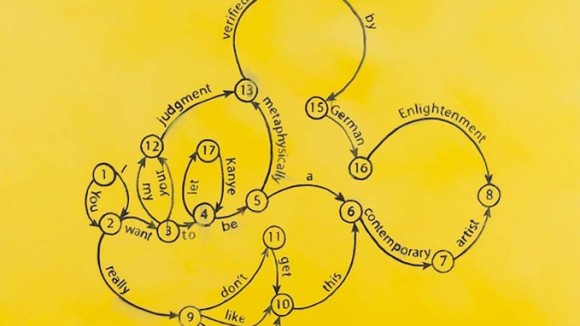

Conceptual Art Meets Classic Cartoon Characters in These Paintings by Antek Walczak

Brooklyn-based gallery Real Fine Arts is currently hosting an exhibition of paintings by Antek Walczak entitled “New Transbohemian States.” The monochrome oil works depict ‘state transition diagrams,’ which as far as I can figure out, are connect-the-dots diagrams of classic cartoon characters with words written along the lines connecting the dots. The words spell out sentences such as “I want to be a contemporary artist” and “Work is much less important than attitude.”
A snarky person might say that the most clever part of Walczak’s work is that he profits from the audience’s familiarity with classic cartoon icons without having to pay the animation rightsholders since his work falls pretty clearly under the umbrella of fair use. According to the gallery’s description of the show, there are plenty of other clever things about these paintings, too, though:
As graphic-poetic machines, these diagrams formulate messages in relation to the outside world (here grounded within the use-case of being a contemporary artist), and each message causes the machine to transition from one state to another, as a hypothetical description of interaction within the behavior of a system. It can be argued that while using the routines and clustering techniques of visualization common to data analysis, the artist has instead opted to venture off into the realm of portraiture, even self-portraits, in an expanded sense of course.
The work of Antek Walczak picks up faint historical echoes of concrete and visual poetry, along with the early conceptual art probing of linguistic systems in the relationship of art and language, while repurposing these informing practices within the current that developed roughly during the same post-war late twentieth century climate to shape the realities and experiences of today. The birth of the computer age, i.e., the continuing effects of information theory and cybernetics across technology development, communications engineering, and the accompanying revolutions in the sciences. For the artist, it is too late to just be awakening to these facts as if some inescapable conspiracy has been hatched that needs to be denounced and held out as a warning to humanity. Rather, to recognize that instead of a pessimistic straightjacket, the notions of the systematic predictability of individuals in given forms of social and economic activity can be grappled with, navigated intensely, to buckle and warp in unexpected ways, instead of serving up the by-now truly archaic conservative way of shocking tradition in positing an empty, fuzzy, nihilistic, blank, chaotic-edgy, post human, techno-futurism.
As test patterns carved out within the ruin of bohemian passion/compassion, underneath the fully-operational wreck of American culture and its biased self-superiority, these tortured and beautiful constellations of moves in the game of contemporary art emerge as a break from critique, a rupture from the all-too-passive intellectual safety of pointing out flaws and defects from a distance. Even in today’s virtual, hands-off methodology, there is the possibility of putting oneself directly in the material, revealing an exquisite sensibility of the nervous system still pulsing in the man-machine template, even if it is experienced as something on the verge of painful collision through several computer and linguistic screen interfaces. What is interesting here is no return to painting, to the oil paints of bohemia in a bygone heroic age for modern art, as is there neither a claim to resurgence in the mythologies of the unheated art studio or cramped writer’s garret. These forms have persisted beyond their one directional anti-bourgeois gestures, mutating in into inner and outer states that transfigure bodies and psychology in a much more fluid and playful way. It remains to be seen how habitual, decidedly alienated notions of network and connectivity, with their frightening disembodied power, how these theoretical and symbolic abstractions-helplessly theorized in the presence of real forces of separation-will hold up in a parallel de-differentiation of individualities and bodies that assemble and seek out more and more dense, interwoven connectivity. The strength of a meshwork, rich and complex in consciousness and creation, after the seemingly headless, centrally auto-controlled, remotely self-regulating network.






